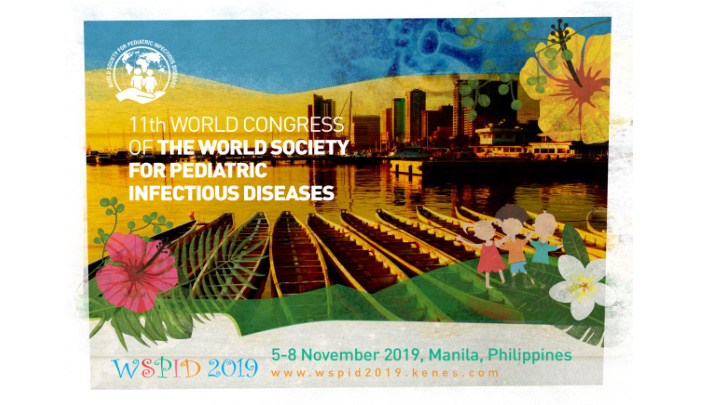



INSTITUTE FOR INFECTION & IMMUNITY Glo lobal Poin int Prevalence Su Surv rvey of f Antimic icrobial Consumption and Resistance (G (Glo lobal-PPS): 20 2015, 2017, 20 2018 Results of f glo global antim imicrobial prescribing for r paediatr tric community-acquired and healt lthcare-associated pneumonia Eva Galiza Paediatric Infectious Diseases Research Group Institute for Infection and Immunity St George’s, University of London World Society of Paediatric Infectious Diseases, Manila Philippines, 2019 egaliza@sgul.ac.uk
Speaker Disclosure No, nothing to disclose Yes, please specify: Ownership/ Honoraria/ Consulting/ Funded Royalties/ Stock Other Company Name Equity Employee Expenses Advisory Board Research Patent Options (please specify) Position Example: company XYZ x x x
Background • Antimicrobials are commonly prescribed drugs in paediatrics and neonates. • Their widespread overuse contributes to significant antimicrobial resistance. • Understanding prescribing practices is paramount in antimicrobial stewardship.
Objectives • This study provides global estimates of antimicrobial use for paediatric community-acquired pneumonia (CAP) and healthcare-associated pneumonia (HAP) by United Nations (UN) regional group.
Study design • A standardized method for surveillance of antimicrobial use in hospitals was used to assess variations in antimicrobial prescribing globally. • PPSs were conducted in 2015, 2017, 2018 in 711 unique hospitals of 73 countries worldwide.
Study design • The survey included all inpatients receiving antimicrobials on the day of the PPS. • A web-based application was used for data-entry, validation and reporting designed by the University of Antwerp (www.global-pps.com). BioMérieux provided unrestricted funding support for the survey.
Results • 35199 paediatric and neonatal patients were admitted of which 14723 (41.8%) were treated with at least one antimicrobial agent. • 3133 (8.9%) patients were treated for pneumonia (80.7% CAP, 19.3% HAP) (table 1).
Results: Global antimicrobial use for CAP and HAP Total Number on Number of Number % patients % patients patients antimicrobials CAP of HAP receiving receiving patients patients antimicrobials antimicrobials for CAP for HAP Africa 3860 296 86 11.7 3.4 2535 East & South Asia 7396 1062 211 26.3 5.2 4035 East Europe 2000 45 52 8.9 10.3 504 North America 2607 74 33 10.2 4.5 727 North Europe 2770 140 22 13.7 2.2 1019 South America 3320 192 81 16.2 6.8 1185 South Europe 3947 234 59 14.0 3.5 1670 West & Central Asia 3725 291 30 18.0 1.9 1615 West Europe 5306 189 32 13.9 2.4 1357 Total 35199 2527 606 17.2 4.1 14723
Results: 10 most commonly prescribed antimicrobials for CAP and HAP. Data shown as proportional use of antimicrobials for CAP and HAP. Antimicrobial CAP (%) Antimicrobial HAP (%) Ceftriaxone 17.1 Meropenem 13.8 Ampicillin 11.0 Amikacin 11.0 Amikacin 7.8 Vancomycin 9.7 Cefuroxime 7.2 Piperacillin and enzyme inhibitor 9.3 Cefotaxime 7.2 Ampicillin 5.5 Amoxicillin 5.0 Cefotaxime 4.6 Gentamicin 5.0 Ceftazidime 4.6 Azithromycin 4.6 Ceftriaxone 3.9 Ampicillin and enzyme inhibitor 4.0 Gentamicin 3.9 Meropenem 3.1 Ciprofloxacin 3.6
Predicted Outcomes Global antimicrobial • 1. Understanding global use antimicrobial use Management strategies • 2. Opportunities exist to improve management strategies Guidelines • 3. Evidence for guidelines
Conclusions • There is wide variation in the proportion of children receiving antimicrobials for CAP and HAP across UN regions with the highest CAP in East and South Asia and the highest HAP in East Europe. • Work is needed to reduce the incidence of HAP across the globe
Acknowledgement • Global PPS • St. George’s, University of London • bioMérieux
Recommend
More recommend